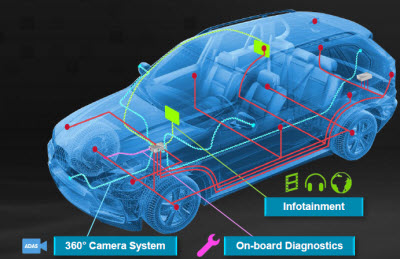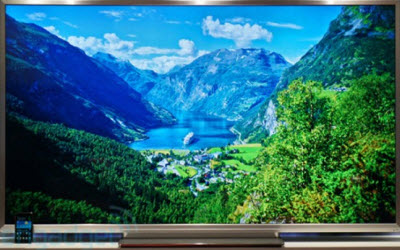The wireless and wired future won’t happen without Broadcom. The company ships more than a billion chips a year for connecting devices in homes and businesses. Its chips are making cars ready for Internet access. They’re enabling faster Wi-Fi. And they’re part of a new home gateway that will allow you to receive 4K Ultra HD video into your home and share it on various screens and devices.
 We caught up with Broadcom’s co-founder Henry Samueli, the former engineering professor who is now chief technical officer, at the Consumer Electronics Show in Las Vegas last week. He told us about new technologies coming down the pipe, such as a compression algorithm dubbed High-Efficiency Video Coding (HEVC), that will allow home networks to transfer 4K video without being overwhelmed with data.
We caught up with Broadcom’s co-founder Henry Samueli, the former engineering professor who is now chief technical officer, at the Consumer Electronics Show in Las Vegas last week. He told us about new technologies coming down the pipe, such as a compression algorithm dubbed High-Efficiency Video Coding (HEVC), that will allow home networks to transfer 4K video without being overwhelmed with data.
He’s also excited about the transition to faster wireless computer networks, or 5G Wi-Fi, which should allow you to transfer video in the home without crashing your wireless network. But he warns that we’re going to have to pay more for our wireless data services.
Samueli walked the floor and told us what was real and what was still a pipe dream. Here’s an edited transcript of our interview.
VentureBeat: What’s on your agenda here at CES?
Henry Samueli: Well, it’s a big show for Broadcom. This is probably the key trade show we attend every year. Primarily we’re highlighting our broadband products. The company’s split into three groups: broadband, networking, and mobile and wireless. For mobile and wireless, the Mobile World Congress, which is next month, is the main show. Networking is Interop and others. Broadband is our focus at CES.
If you look at the key things going on at the show — and you’ve probably seen a lot of this on the floor besides Broadcom — it’s the whole UltraHD phenomenon. Broadcom just today introduced our BCM7445 (in TV pictured at top), which is a big step forward in set-top box technology. We’re just introducing it now, sampling it. It probably won’t hit the consumer production level until the middle of next year. I’ve walked around the show floor to get a feeling for some of these UltraHD displays, and they’re pretty remarkable.
 VB: And the problem is that they generate about four times as much data, I guess?
VB: And the problem is that they generate about four times as much data, I guess?
Samueli: That’s the key. The big advancement in our BCM7445 home gateway chip is that it uses the next-generation compression technology called HEVC — High-Efficiency Video Coding. That cuts the bitrate in half for the same quality. You’ll see it side by side. Even though the bitrate of the 4K by 2K goes up, when you cut that in half, you’re still at a very reasonable bitrate for the carriers.
VB: So it’s about two times, if I get my math right.
Samueli: Right. Exactly.
VB: There’s still the problem of trying to handle twice as much data as they would normally…
Samueli: You’re not going to see a wholesale switch over to all 4K by 2K. It will start with one, two, three, four channels, just like high definition (HD) when it was first introduced. Then there will be more and more. Now, today, most channels are HD. I think it’ll take maybe 10 years before you see a wholesale switch over to UltraHD, but it will happen over time.
The network capacities are expanding. I’m not worried about that. I think you’ll see a nice, gradual shift into UltraHD, especially once the sets come down in price. Today they’re $20,000 dollars or whatever, but as they come down over the next five to 10 years to the same cost as standard full HD today…
VB: Out of curiosity, what will people do when 8K comes along and it’s 16 times as much data?
Samueli: Same thing. [laughs]
VB: Sharp just introduced one of those.
Samueli: Did you see it?
VB: Not yet, no.
Samueli: Oh, you have to go see it. It’s remarkable. You can stand three inches in front of the screen and still not see the pixels. They’re so tiny. It’ll come along, five years or whatever down the road.
Anyway, probably the hottest thing at the show is the whole UltraHD phenomenon. TV sets are first, but without content, you have nothing. That’s all made-up content you’re seeing on these TVs. The next step is getting the carriers to deliver it, and therefore they need set-top boxes to decode it. That’s where step two comes in. We’re starting to work with the carriers. You’ll probably see the satellite carriers, because they’re more constrained by bandwidth… They want the additional bandwidth reduction of the HEVC. They may even use it on high definition, just to get a lower bitrate.
VB: Is the transition reasonably paced, as far as you can see? Is it going to happen naturally?
Samueli: Yes. I don’t think it’s unnatural…
VB: When HD came along it was a decades-long process, right?
Samueli: Same thing is going to happen with 4K. It’s really price-driven in the end. The consumer, given the choice of spending $1,000 dollars for a full HD screen or $10,000 dollars for a UltraHD screen, is going to buy the full HD screen. It’ll be five to 10 years before the prices hit those levels. Price regulates the demand and adoption of new technology.
VB: So the 4K technology ecosystem has time to grow up.
Samueli: Exactly. In the 2015 time frame, you’ll probably see more mainstream adoption of set-top box technology using UltraHD. We’ll start shipping it in 2014, but the volume will take off in probably 2015. It’s a slow, natural evolution. There’s no major rush for it. But it’s an exciting transition because it’s a major shift.
We had the hype for 3D TV, which didn’t do too well. I was never a fan. The glasses phenomenon just doesn’t work for me. This is a whole different thing, though. It doesn’t require any glasses. It’s just a better screen. As long as the price is there, people will adopt it.
Another thread that we’re really excited about is the proliferation of wireless everywhere. 5G Wi-Fi in particular. The whole new push to the next generation of Wi-Fi has really opened up new opportunities for media sharing in the house. Older generations of Wi-Fi weren’t quite robust enough to deliver video in the home without breaking up and losing packets and so forth. 5G Wi-Fi gives you extended reach, extended data rates, and more robust coverage. The carriers are now willing to accept Wi-Fi in the set-top box with the 5G Wi-Fi. We’re getting designed in all over the place.
VB: How does 5G Wi-Fi do with 4K video transfer?
Samueli: It should be fine. Again, with double the speed, you’re still okay. If you have a data rate of 10 to 20 megabits per second, you can easily handle that with a 5G Wi-Fi network. It’s not going to be an issue to upgrade video distribution to 5G Wi-Fi. But the devices now are all adopting the software protocols to allow that, like Miracast, which is the Wi-Fi protocol that lets you have peer-to-peer from your phone direct to your TV. You can plug in a little USB dongle to your TV set with a Wi-Fi chip on it that’s enabled with the Miracast software. Then, if your phone has Miracast — which all the latest-generation phones will — you could be watching YouTube on the phone, you hit the button, and boom, it’s showing on your TV set. Media sharing in the house is going to be a big thing going forward for the next few years. We’re proliferating our Wi-Fi technology everywhere. It’s going into thermostats, home appliances, you name it.
VB: For a while, it seems like we’ve had a wireless logjam. Not only in the house with Wi-Fi, but also with mobile data networks. Are you optimistic that these things are going away, that we’re going to be able to do these things as fast as we can on the wired internet?
Samueli: I think it’s getting pretty close to wired internet speeds. If you look in your home today, gigabit is the maximum speed you could expect to get. With 5G Wi-Fi you can get to gigabit speeds. We just introduced new MoCA technology, which is home networking over the coax cable that already connects up your TVs. We have a demo here of a gigabit MoCA. So we have gigabit Wi-Fi, gigabit MoCA, gigabit ethernet. Powerline is getting close to a gigabit.
VB: And then everybody uploads some 4K video to YouTube and clogs it all up again.
Samueli: Right. [laughs] Once you have the bandwidth, people will find something. The quality of the streaming will go up. Right now YouTube is fairly low resolution, but as you start watching it on a 60-inch TV instead of your phone, you’re going to want higher resolution and you’ll need a higher-bitrate YouTube. You’ll need the 5G Wi-Fi technology to handle that.
It’s an endless cycle. You get more bandwidth in the home. You get more quality video, which demands more bandwidth, which demands more quality. It never ends. But I think that with gigabit home networking, you’ve got enough bandwidth to handle pretty much all the needs you want for a family all watching independent HD video streams, or even UltraHD quality.
VB: I have to carry around a MiFi now. I’m not happy that a larger percentage of my household income is going towards getting bandwidth in some way. [laughs]
Samueli: That’s the other issue, the economics of it. People are going to start demanding gigabit services from their carriers, and that’s not free. They’re going to charge you for more bandwidth. That may be the regulating phenomenon. Just like how the cost of the flatscreen regulates how many people adopt it, the cost of bandwidth to your house could regulate how much you’re willing to use.
VB: What trend do you think will win out there? Is bandwidth going to get more expensive, or thanks to folks like Google, is it going to be free?
Samueli: No. Fundamentally, bandwidth is not cheap. You have to install a lot of infrastructure. It’s not obvious that the Google model will scale nationally. They can wire up a city to test it, but to wire up a country is expensive. It’s not clear that you can give away the service for free and build a business model out of that. We’ll see. Maybe they can.
VB: If we do a lot more Google searches…
Samueli: [laughs] Exactly. If you can get enough advertising in there, you might be able to do it. At least in the short-term, the mainstream carriers will likely have to charge more for more bandwidth.
VB: Is all of your mathematics done, or do you have other challenges ahead?
Samueli: There are always challenges. Every technology has a next generation, even on the mobile side. You have LTE (Long-Term Evolution), but there are five different flavors of LTE going forward. The first generation of LTE was introduced with 75 megabits per second. It was called Category 3. Then Category 4 is now 150 megabits per second, which I think is in the iPhone 5. Then you go to Category 6 with 300 megabits. Then you’ll have a 600 megabit LTE. LTE is going to keep increasing in data rates, which means you have to have more sophisticated chips inside the phones to process the signals. Then the cable modem speeds are going to continue to go up. It’s endless. Our guys are always inventing new algorithms and new signal processing techniques to figure out how to get more bandwidth through the same airwaves and the same wires. There’s still more mathematics to be evolved before we’re done, if we’re ever done. I don’t know if we’ll ever be done.
VB: [OnLive founder] Steve Perlman had an interesting talk about DIDO — Distributed In, Distributed Out. It was a way to get around the limitations of Shannon’s Law by basically figuring out where somebody was and directing wireless signals to them, so that they could — in a given cell site area — get the full bandwidth available in that area. Rather than splitting it up with 100 other people, you all get 25 megabits a second.
Samueli: Yeah, yeah. That goes by many names. MIMO is a more common name for it, but it’s basically the same thing, where you have multiple antennas in both your handset and especially in the base station. You could put a whole array of antennas in the base station and steer the beam to a very narrow target, right to the person you want it to go to. If 10 people are around, you have 10 independent beams being steered, each with its own dedicated bandwidth.
That technology, or at least the systems algorithms, is worked out and well known. It’ll eventually get into the cellular network. It’s probably going to take a decade or so, but I think we’ll get there. Even in our access points today, we do some beam steering technology. Our 3×3 11AC access points have beam forming technology where you can steer the beam towards the client and increase throughput. It’s very sophisticated technology.
VB: Why might that take a decade, that part?
Samueli: You have to upgrade all of the cellular infrastructure to accommodate that. New base stations. That’s a slow process. People know how to do it, but it’s a matter of deploying it. That’s not easily done.
VentureBeat's mission is to be a digital town square for technical decision-makers to gain knowledge about transformative enterprise technology and transact. Learn More

